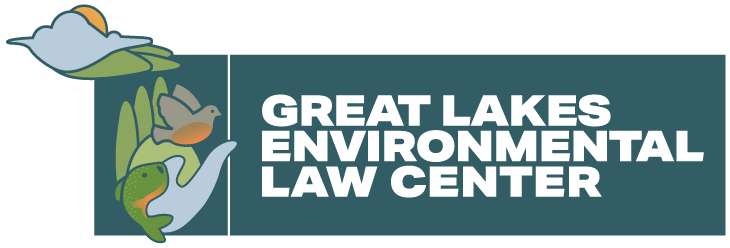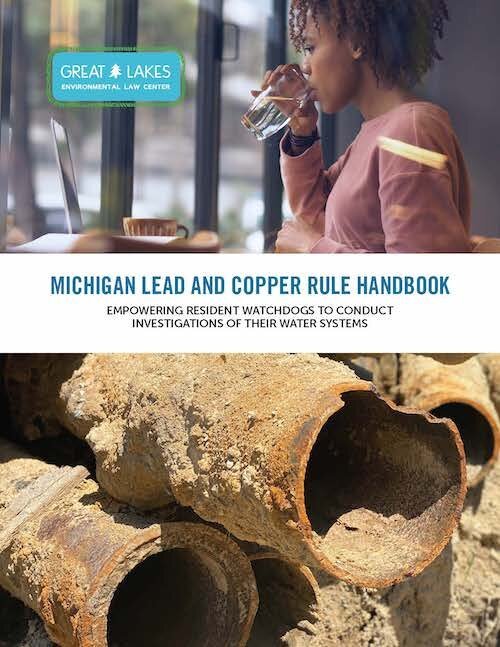
Resources
Air Quality Trackers
We compile and update an Air Quality Permit Tracker and an Enforcement Tracker as a public resource.
The Permit Tracker compiles permit installation applications, public hearing information, links to all finalized permits to install, and more. This resource helps residents more meaningfully participate in air quality decisions that will impact their health and quality of life.
The Enforcement Tracker compiles violations of air quality regulations at major sources of air pollution in Wayne County and enforcement actions taken by the Michigan Department of Environment, Great Lakes, and Energy (EGLE) to address the violation from multiple databases.
Reports
Michigan Lead and Copper Rule Handbook: Empowering Resident Watchdogs to Conduct Investigations of their Water Systems
The Flint Water Crisis was identified not by water system operators or government officials, but by resident watchdogs that continued to raise the alarm despite being constantly told that their water was safe to drink.
This Handbook has been created to help residents understand what the Michigan Lead and Copper Rule requires, and how residents can engage with the Michigan Department of Environment, Great Lakes, and Energy as well as their local water department. It also provides over 20 sample Freedom of Information Act Requests and over 30 watchdog actions that residents can pursue to get the answers they need.
Legal Pathways to Income-Based Drinking Water Rates in Michigan
As thousands of residents in Detroit and beyond have confronted the reality of being unable to afford drinking water, they have advocated to ensure that all residents can afford running water. However, in Michigan these calls have been consistently rejected on the grounds that such a rate would violate the Michigan Constitution’s Headlee Amendment, which requires local governments to obtain voter approval before enacting or increasing any tax.
This report evaluates the legal validity of income-based water rates in Michigan, and concludes that such a rate structure would not violate any Michigan law. It also describes how local governments in Michigan have routinely authorized lower rates or discounts for municipal services.
Protecting Drinking Water in the Great Lakes
In partnership with American Rivers, the Center published this report to compare how the 8 Great Lakes states are addressing 10 drinking water issues impacting the region:
Maximum contaminant levels, treatment techniques, and monitoring standards
Lead as a drinking water contaminant
Consumer confidence reporting
Loans and grants
Public participation in standards, permits, and enforcement
Operator certification
Management of drinking water emergencies
Management of algal blooms and their consequences
Private water supplies: well construction and protection from pollution
Per- and Polyfluoroalkyl Substances (PFAS) and Drinking Water
Furthering Environmental Justice in Air Quality Enforcement with Supplemental Environmental Projects
In Michigan, the penalties assessed against a violator of an environmental law or regulation go to the state general fund. This leaves the communities that have been directly impacted by the emissions or discharges that impact their quality of life with no redress for the harm they have suffered. Supplemental environmental projects” are environmentally beneficial projects that a violator may agree to undertake as part of the terms of an enforcement action that is initiated due to a violation of some environmental quality standard. This report:
Describes how supplemental environmental projects may be used to further environmental justice
Compares Michigan’s policy to the U.S. EPA’s policy, as well as several other state policies.
Identifies obstacles to the robust use of supplemental environmental projects as a tool to further environmental justice in enforcement, and provides recommendations for revisions to Michigan’s policy
Lessons from the Frontlines of the Benton Harbor Water Crisis: A Community Perspective on Preventing Lead Crises and Proactively Addressing Benton Harbor’s Growing Water Affordability Crisis
Shortly after the Flint water crisis began, numerous new policies were enacted to enable federal and state agencies to better prevent and respond to similar crises. However, less than five years later, not only did federal and state government fail to prevent another lead crisis in a majority Black city, it also took longer to institute a robust, public health focused response to protect residents.
This report examines how policies enacted after the start of the Flint water crisis failed to protect Benton Harbor residents and what must be done to ensure a similar crisis never occurs again. It also examines Benton Harbor’s growing water affordability crisis and includes recommendations for ensuring Benton Harbor residents have affordable and safe drinking water.
Vegetative Buffers and Tree Canopy
In partnership with a team of multi-disciplinary Masters students from the University of Michigan, the Great Lakes Environmental Law Center developed this report detailing how local governments can promote the development of increased tree canopy and vegetative buffers to improve local air quality and public health.
The report integrated case studies from leading cities, insights from a community engagement workshop in Detroit, and modeled the implementation of increased tree canopy and vegetative buffers at three Detroit sites.







